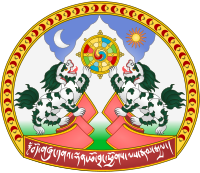Buddhistische Symbole
( In Vorbereitung)
"In der Bergeinsiedelei, die mein Körper ist,
Im Tempel meiner Brust
Auf dem Gipfel des Dreiecks meines Herzens,
fliegt das Pferd, das mein Geist ist wie der Wind.
Es galoppiert auf den Ebenen von großer Glückseligkeit.
Wenn es besteht, wird es den Rang eines siegreichen Buddha erreichen.
Rückwärts gehend durchschneidet es die Wurzel des Samsara.
Zukünftig erreicht es die hohen Grundstücke der Buddhaschaft.
Rittlings wie ein Pferd erreicht man die höchste Erleuchtung."
(Milarepa, Das Lied vom galoppierenden Pferd eines Yogi)
Der Buddhismus verwendet besonders im Vajrayana eine ausgeprägte Symbolik.
Die acht buddhistischen glückverheißenden Symbole bestehen aus:
- der Schirm (Sanskrit: chhatra; Tib. gdugs)
- die goldenen Fische (Sanskrit: suvarnamatsya; Tib. gser nya)
- die Vase (Sanskrit: nidhana kumbha; Tib. gter gyi bum pa)
- die Lotosblüte(Sanskrit: padma; Tib. pad ma) symbolisiert die Reinheit
- das Muschelhorn (Sanskrit: shankha; Tib. dung dkar)
- der endlose Knoten (Sanskrit: shankha; Tib. dung dkar)
- die Standarte (Sanskrit: dhvaja; Tib. rgyal mtshan)
- das (Lebens-)Rad (Sanskrit: dharmachakra; Tib. 'khor lo)
- die Schädelkette - Sieg über die niederen Kräfte
- Yantra
- Schädelkette - Überwindung der niederen Kräfte
- Das Weisse Pferd - universelle Liebeskraft
Die sieben Juwelen =
Die 7 Juwelen königlicher Macht sind die Accessoires des Chakravartin.
Für den spirituellen Praktiker repräsentieren die 7 Juwelen grenzenlose Weisheit, unerschöpfliche spirituelle Resourcen und unbesiegbare Kraft über alle inneren und äußeren Hindernisse.
- Die wertvolle Königin - der weibliche Aspekt des Chakravartin. Those working to abandon negative mental states regard her as mother or sister. Her beauty and love for her husband are representative of the radiating, piercing joy of the Buddha's enlightenment.
- The Precious General symbolises the wrathful power to overcome enemies.
- Das wertvolle Pferd - es kann zwischen den Wolken wandern and mirror the Buddha's abandonment of, or "rising above", the cares of worldly existence.
- The Precious Jewel which is sometimes depicted on the back of the precious horse, deals with the themes of wealth and unfolding (power and possibility). The jewel is said to aid the Chakravartin (Wheel-turning or Buddhist King) in his ability to see all things like a crystal ball. In the same way, a Buddha can perceive all things; recognising the manifold connections between all events, the relentless chain of cause and effect, and the nature of compounded existence. The Jewel can also symbolise a Wish-granting Jewel, a mythical gem which fulfills all wishes.
- Der wertvolle Minister oder Haushalter repräsentieren zwei verschiedene Aspekte of the rule of the chakravartin which are closely related. The minister aids the chakravartin in carrying out his commands expeditiously, while the householder provides the very basic support. The wisdom of the Buddha, like the minister, is always present to him who has realised it, allowing him to cut through the bonds of ignorance. While the householder represents the support of the lay community, without which the monastic community could not continue.
- Der wertvolle Elefant : Er symbolisiert die Stärke des Geistes. Exhibiting noble gentleness, the precious elephant serves as a symbol of the calm majesty possessed by one who is on the path. Specifically, it embodies the boundless powers of the Buddha which are miraculous aspiration, effort, intention, and analysis. The image at the right says it all: a stupa - symbolic of the mind of a Buddha with a basis of strong elephants.
- Das wertvolle Rad - manchmal auch auf dem Rücken des wertvollen Elefanten abgebildet, ist identisch mit dem Dharmachakra - Rad der Wahrheit.<ref> http://viewonbuddhism.org/general_symbols_buddhism.html <7ref>
Literatur
- Buddhistische Symbole ,Tatjana Blau (Autor), Mirabai Blau, Verlag Schirner, 1999, ISBN-10: 3930944642, ISBN-13: 978-3930944644
- Buddhistische Symbole PDF
- Beer, Robert (2003) The Handbook of Tibetan Buddhist Symbols ISBN 1-932476-03-2
- Dignaga on the Interpretation of Signs, R.P. Hayes, Springer, 1988, ISBN-10: 9027726671
- Handbook of Tibetan Buddhist Symbols, Robert Beer, Publishers Group UK, 2003
- The Buddhist Tantras: Light on Indo-Tibetan Esotericism (Buddhist Tradition Series), Alex Wayman, Motilal Banarsidass, 1990 [Voransicht online)
Weblinks
- Buddhist symbols
- Tibet-galerie : Symbole 2
- Buddhistische Symbole
- 8 Symbole
- General symbols
- Tibet.de : Tantrische Ritualgegenstände und ihre Bedeutung
- Symbolik der Ngakpas
- Wikiportal : Buddhistsiche Symbole
- Meaning of the
- Tibetan buddhist symbolsPeacock feather
- The Horse

